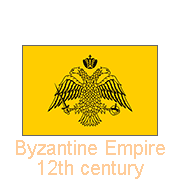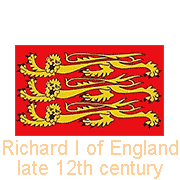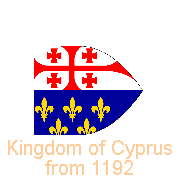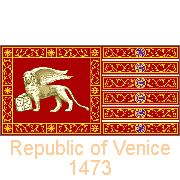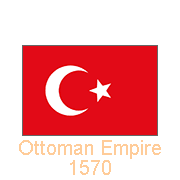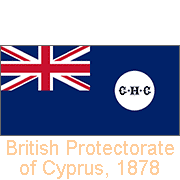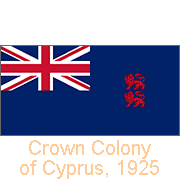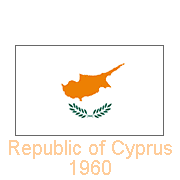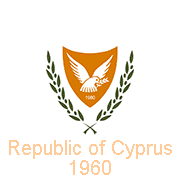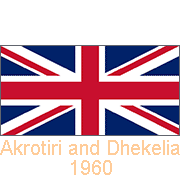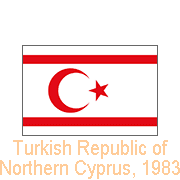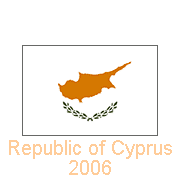Flags from Cyprus
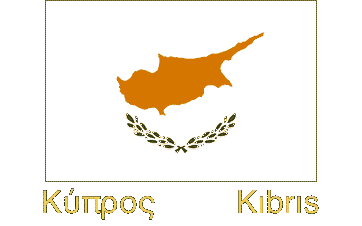
A Flag history of Cyprus
The Roman Republic incorporated the island of Cyprus in 58 BCE. Until the late 12th century, Cyprus remained part of the Roman and later the Eastern Roman or Byzantine Empire. Its symbol was a double-headed eagle with a sword, a Globe and a crown. The Greek Orthodox Church, retaining its Byzantine culture, still uses this flag. King Richard I, “Lionheart”, captured the island during the Third Crusade in 1191; his banner displayed three lions on a red background, a feature retained throughout history in English heraldry. He sold it a year later to the Knights Templar, who sold it in turn to Guy de Lusignan, a French Poitevin knight who had been the ruler of the Kingdom of Jerusalem, a Crusader state. Guy de Lusignan founded the Frankish Kingdom of Cyprus that lasted for almost three centuries. Their banner combined the symbols of the previous kingdom of Jerusalem with, on a blue background, “fleur de lis”, a stylised lily used by French royalty and throughout history to represent the Catholic saints of France.
you may then send it as a postcard if you wish.
The last Lusignan monarch, Queen Catherine Cornaro, was forced to sell the island to Venice in 1489 when her kingdom had lost almost all independence. The Republic of Venice, a powerful sovereign and maritime Republic founded in 697 CE, took control and formally annexed Cyprus in 1489. The Most Serene Republic of Venice flag displayed a winged lion, the symbol of the Evangelist Mark, with a paw on a book with the Latin inscription “Peace be with you, Mark, my Evangelist”. The Venetians fortified the island because of raids by the Ottoman Empire, but in 1570 Ottoman forces invaded Cyprus and brought it under its control. Ottoman rule lasted for over four centuries, and during that time, Turkish immigrants were brought in from Anatolia, the ancestors of the Turkish Cypriot population. The Ottoman flag, initially green, became red in 1793, with a white crescent moon and eight-pointed star. In 1844 the flag got its modern design. The crescent represents progress, and the five-pointed star stands for light and knowledge, now often considered a symbol of Islam. It has remained the flag of modern Turkey.
In 1878, in the aftermath of the Russo-Turkish war, the British Empire took over the island’s administration, while the island de jure remained an Ottoman territory. At the First World War outbreak in 1914, it was formally annexed by the United Kingdom. The flag used, dating from 1881, was a blue British Ensign, displaying the letters “CHC”, Cyprus High Commission on a white badge. In 1925, the United Kingdom declared Cyprus a Crown Colony. Its flag, dating from 1922, displayed, on a blue British Ensign, two red lions, based on the coat of arms of the United Kingdom, either directly on the flag or on a white circle, the badge used unofficially by British colonial officials since 1905.
On 16 August 1960, the Republic of Cyprus came into being. Until then, the two communities had used the flags of Greece and Turkey. A design competition was held in 1960. Under the constitution, the flag should have a neutral design, without Greek, Turkish or religious symbolism. The winning design was that of Turkish Cypriot artist İsmet Güney. The flag was white as a symbol of peace among Greek and Turkish Cypriots. It featured a map of the island (originally just in outline) in the brown-red colour of copper: the ancient Greeks mined copper here, and the island’s name derives from their word for it. Two olive branches, symbols of peace, were below it. The flag’s aspect ratio was 3:5. In April 2006, the design was updated: the map of the island was slightly enlarged, and the copper colour changed to a golden yellow, a colour easier to reproduce and one that is more common in heraldry. The two olive branches were slightly altered, and the flag’s aspect ratio changed to 2:3. The coat of arms of the Republic of Cyprus displays a dove carrying an olive branch, symbolising peace and “1960”, the year of independence from British rule. The background is a copper-yellow colour for the large deposits of copper ore on Cyprus: its names are related. The two-part wreath represents the two ethnic groups of Cyprus, Greeks and Turks.
When Cyprus became independent in 1960, the British retained two military bases on the island, the Sovereign Base Areas of Akrotiri and Dhekelia, under an agreement by the United Kingdom, Greece, Turkey and representatives from the Greek and Turkish Cypriot communities. The areas house British military bases and installations and serve an essential role in intelligence gathering and network monitoring in the Mediterranean and the Middle East. Akrotiri is in the south of the island near Limassol. Dhekelia is in the southeast, near Larnaca, bordering the UN buffer zone and the area controlled by the Turkish forces. The flag used is that of the United Kingdom.
On 15 November 1983, the area of Cyprus to the north of the United Nations buffer zone north unilaterally declared its independence as the “Turkish Republic of Northern Cyprus”. Only Turkey recognised it; the international community rejected it. In 1984 it adopted a flag, designed by Turkish Cypriot artist Emin Çizenel. It displays a red star and crescent slightly to the left of the centre between two horizontal red bars on a white field. Its aspect ratio is 2:3. The coat of arms of this internationally unrecognised state is styled closely on the arms of the Republic of Cyprus. The date “1960” is replaced with “1983”, and the Turkish star and crescent emblem are added above the shield. According to the constitution, private citizens may fly the flag of Cyprus alongside either the Greek flag, the Turkish flag, or both. Since the Turkish invasion of 1974, the Greek and Republic flags are the only ones seen in the south of the island. Similarly, the flag of Turkey is only seen side-by-side with the flag of the Turkish Republic of Northern Cyprus in the north.


